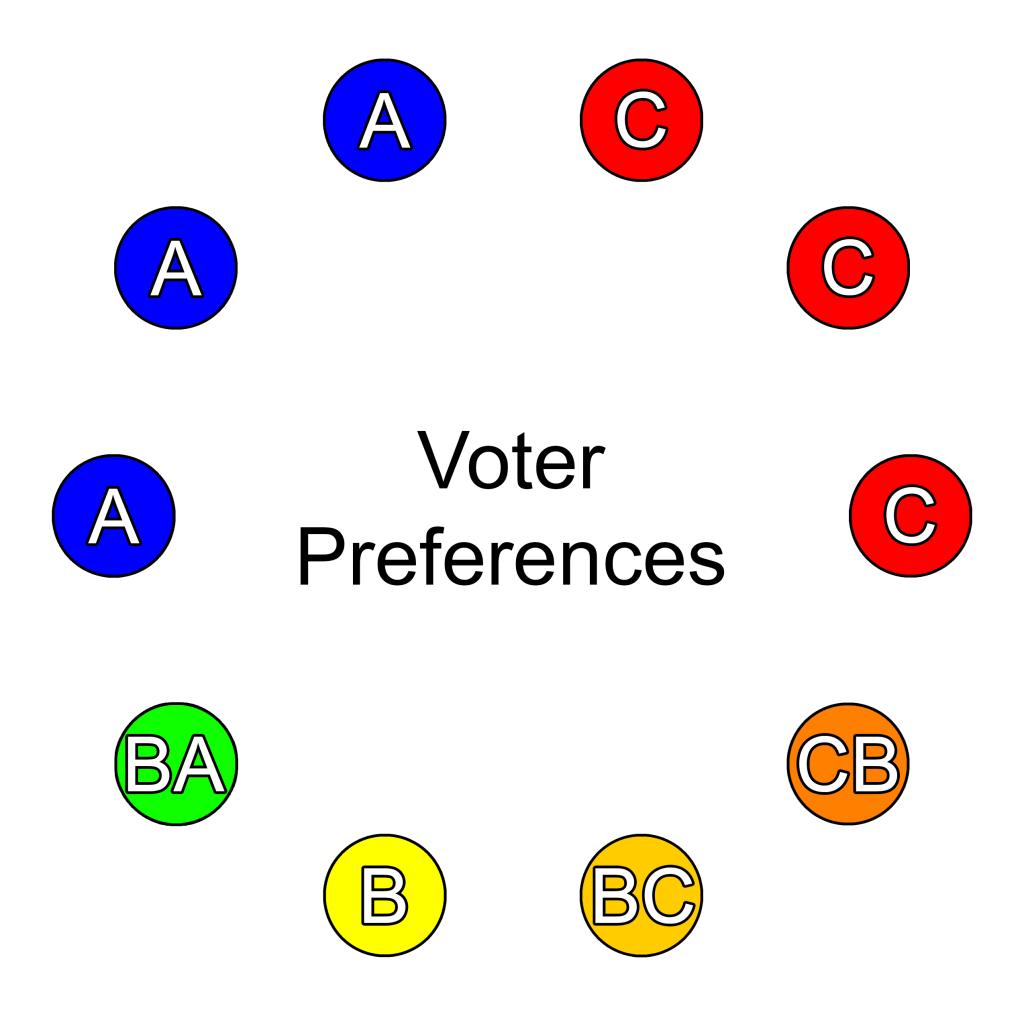
Introduction
A vote between something awful and something worse isn’t a great choice. Yet for many democracies, this is the unfortunate dilemma plaguing voters. This is a side effect of plurality (One choice, one vote) voting, which limits voter expression, encourages hyper-partisanship, and suppresses political innovation.
A very straightforward change to the voting system, called “Approval Voting,” allows voters to vote honestly, while also allowing compromise and political innovation. Want to learn how? Read on!
Author’s Note
The following is an introduction to Approval Voting. Dive deeper into the topic by visiting The Center For Election Science. There are other voting systems, such as Instant Runoff Voting and Score Voting, that are also better than plurality voting.
Approval voting is discussed here largely because it is the most straightforward reform, and because it empowers voters to always vote for their preferred candidate. It’s worth researching other reforms as well.
Another important consideration is when to use Sociocratic consent-based decision making versus when to vote. Voting may be necessary in some cases, but it should by no means be a default decision-making tool.
The Colortown Elections
Candidates
Colortown has a contentious election coming up. Three candidates are running for a position: A, B, and C. These candidates are fictional, and are not meant to represent real-life political parties. Candidates A and C are extremely partisan. Candidate B’s policies have appeal across the political spectrum.

Voter Preferences
Voter preferences in Colortown are represented in the graphic below. Each circle represents a voter block, while each voter’s candidates of choice are shown in order from first choice to second choice (If they like more than one candidate).

Plurality Voting
Plurality voting is where each voter chooses a single candidate. In the Colortown graphic above, the voters’ first-place preferences are as follows:
- 3 prefer A
- 3 prefer B
- 4 prefer C
Stifled Expression
Notice a problem? If everyone votes their preference, the BA voters will throw the election to candidate C, who they dislike. The BC voters also risk reducing support for candidate C by voting their preference. Therefore, to avoid an outcome they don’t like, it’s in the best interest of the BA and BC voters to vote against their preference.
Hyper-Partisanship
A vote for B risks throwing the election. Therefore, it is in the interest of both parties to pull supporters away from B, which means, in practice, to pull them further to the political fringes. This leads to hyper-partisanship. Can you think of any examples of this in real life elections?
Suppressed Innovation
This spoiler effect also makes it extremely hard for new ideas to enter the political ecosystem. This is because, whenever a new candidate or party enters a plurality election, they risk drawing vital support away from other candidates.
Approval Voting
There’s a very simple way to lessen the problems caused by plurality voting: allow voters to pick as many candidates as they want to! This process is called Approval Voting. Let’s apply approval voting to the Colortown elections:

Voters’ approval rates for each candidate are as follows:
- 4 approve of A
- 4 approve of B
- 5 approve of C
Everyone Can Vote Their Preference
In approval voting, it is never disadvantageous to vote for your preference. Supporters of B can now safely vote for their preferred candidate, while voting for another candidate as a backup choice. It is now also nearly impossible for voters to throw elections to candidates they don’t like without voting for them (And why would anyone do that?).
Collaboration Is Possible
Since voters can vote for every candidate they approve of in approval voting, a vote for one candidate does not automatically take away votes from another candidate. This opens the door for a more collaborative political dialogue. B now benefits from broad political appeal, instead of being inherently punished for it. A and C also benefit, in that B votes no longer automatically steal support from them.
Innovation Is Possible
Votes for new candidates do not automatically take votes away from entrenched candidates. This means that new candidates, parties, and ideas, are not inherent threats in an approval election. It opens the door for political innovation, instead of incentivizing stagnation.
All Voting Systems Have Problems
All voting systems have problems. What are approval voting’s downsides?
Voting for more than one candidate can cause a voter’s first place candidate to lose. Therefore, some voters are incentivized to only vote for their favorite candidate. This is known as bullet voting. The more people do this, the closer election results get to plurality results.
Pay close attention, though. Even if every single voter chose to bullet vote (Which is highly unlikely), approval voting would still be no worse than plurality voting. Additionally, there is never a reason not to vote one’s preference under approval voting. There are lots of reasons not to vote one’s preference under plurality voting.
Approval voting’s potential downsides are not a valid reason to stick with plurality voting, since approval voting performs better even when it’s gamed.
Conclusion
Plurality voting is objectively terrible. Approval voting provides a simple and meaningful alternative.
Resources
Videos
- An informative video simulating plurality voting, instant runoff voting, and approval voting:
- An excellent series of videos discussing alternative voting and representation systems, by CGP Grey:
Books
- A deep dive into approval voting:
Organizations
- The Center For Election Science:
Community
- The Humano Ludens Discord community: